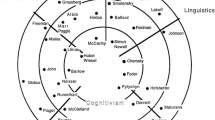Abstract
In this paper the authors reflect on the contents of this current issue of ZDM and ask why focus an entire issue on enactivism as a research methodology in mathematics education. In their synthesis of the papers they distinguish and explicate what they observe as three moves in the enactivist research discussed. The first move (and the one that receives much of the attention in the papers) is that of the observer. Enactivism proposes the observer is one who arises in the act of observing and whose knowing is explained through the mechanism she describes. The second move is an understanding that all knowing is perceptually guided action that brings forth a world of significance. The third is a consequence of the first two: All knowing has implications. Hence that third move is towards ethics. The observer is not neutral; her observations bring forth worlds of significance that intersect with the worlds of others. They conclude, that the strength of enactivism as a methodological frame for mathematics education research is that it is a form of research that is incomplete. Incomplete in that from this framework there is necessarily always more to be said and different grounds for the saying about the phenomena under investigation in mathematics education.


Similar content being viewed by others
Notes
Maturana and von Foerester have never called themselves enactivists. Neither has Varela, but the language Varela uses makes it easier to justify calling him one. See comments by Reid and Mgombelo in this issue.
References
Abrahamson, D. & Trninic, D. (2015). Bringing forth mathematical concepts: signifying sensorimotor enactment in fields of promoted action. ZDM Mathematics Education, 47(2) (this issue). doi:10.1007/s11858-014-0620-0.
Coles, A. (2015). On enactivism and language: towards a methodology for studying talk in mathematics classrooms. ZDM Mathematics Education, 47(2) (this issue). doi:10.1007/s111858-014-0630-y.
Davis, B., Sumara, D., & Kieren, T. (1996). Cognition, co-emergence, curriculum. Journal of Curriculum Studies, 28(2), 151–169.
Khan, S., Francis, K. & Davis, B. (2015). Accumulation of experience in a vast number of cases: enactivism as a fit framework for the study of spatial reasoning in mathematics education. ZDM Mathematics Education, 47(2) (this issue). doi:10.1007/s11858-014-0623-x.
Kieren, T., & Simmt, E. (2002). Fractal filaments: a simile for observing collective mathematical understanding. In D. Mewborn, P. Sztajn, D. White, H. Wiegel, R. Bryant, & K. Nooney (Eds.), Proceedings of the 24th Annual Meeting North American Chapter of the International Group for the Psychology of Mathematics Education (pp. 865–874). Columbus: ERIC.
Kieren, T. & Simmt, E. (2009). Brought forth in bringing forth: the inter-actions and products of a collective learning system. Complicity: An International Journal of Complexity and Education 6(2), 20–27.
Kieren, T., Simmt, E. & Mgombelo, J. (1997). Occasioning understanding: understanding occasioning. In Proceedings of the 19th annual meeting of the North American Chapter of the Psychology of Mathematics Education. Columbus: The ERIC Clearinghouse for Science, Mathematics and Environmental Education.
Lozano, M-D. (2015). Using enactivism as a methodology to characterise algebraic learning. ZDM Mathematics Education, 47(2) (this issue).
Maheux, J-F. & Proulx, J. (2015). Doing|mathematics: analysing data with/in an enactivist-inspired approach. ZDM Mathematics Education, 47(2) (this issue). doi:10.1007/s11858-014-0642-7.
Maturana, H. (1980). The biology of cognition. In H. Maturana & F. Varela (Eds.), Autopoiesis and cognition: the realization of the living. Boston: D. Reidel.
Maturana, H. (1988a). Reality: the search for objectivity or the quest for a compelling argument. The Irish Journal of Psychology, 19(1), 25–82.
Maturana, H. (1988b). Ontology of observing: the biological foundations of self consciousness and the physical domain of existence. In Donaldson, R. (Ed.), Texts in cybernetic theory: an in-depth exploration of the thought of Humberto Maturana, William T. Powers, and Ernst von Glasersfeld, Felton CA: American Society for Cybernetics (conference workbook). http://ada.evergreen.edu/~arunc/texts/cybernetics/oo/old/oo.pdf. Originally published in E. Caianiello, (Ed.) (1987). Physics of Cognitive Processes (pp. 324–379). Singapore: World Scientific.
Maturana, H. (2005). The origin and conservation of self-consciousness: reflections of four questions by Heinz von Foerster. http://www.univie.ac.at/constructivism/pub/hvf/papers/maturana05selfconsciousness.html. Originally published in Kybernetes 34(1/2), pp. 54–88.
Maturana, H., & Varela, F. (1980). Autopoiesis and cognition: the realization of the living. Boston: D. Reidel.
Maturana, H. & Varela, F. (1987/1992). The Tree of Knowledge: the biological roots or human understanding. Boston: Shambhla.
Metz, M. & Simmt, E. (2015). Researching mathematical experience from the perspective of an empathic second–person observer. ZDM Mathematics Education, 47(2) (this issue). doi:10.1007/s11858-014-0621-z.
Mgombelo, J. (2006). Teaching and ethics in complexity science: the ethics of absolute unitary being. Complicity: An International Journal of Complexity and Education 3(1), 21–38.
Preciado-Babb, A., Metz, M., & Marcotte, C. (2015). Awareness as an enactivist framework for the mathematical learning of teachers, mentors and institutions. ZDM Mathematics Education, 47(2) (this issue). doi:10.1007/s11858-014-0657-0.
Reid, D. & Mgombelo, J. (2015). Survey of key concepts in enactivist theory and methodology. ZDM Mathematics Education, 47(2) (this issue). doi:10.1007/S11858-014-0634-7.
Simmt, E. (2000). Mathematics knowing in action: a fully embodied interpretation. Unpublished doctoral dissertation. Edmonton: University of Alberta.
Steinbring, H. (2015). Mathematical interaction shaped by communication, epistemological constraints and enactivism. ZDM Mathematics Education, 47(2) (this issue). doi:10.1007/s11858-014-0629-4.
Towers, J. & Martin, L. (2015). Enactivism and the study of collectivity. ZDM Mathematics Education, 47(2) (this issue). doi:10.1007/s11858-014-0643-6.
Varela, F. (1999). Ethical know-how: action, wisdom, and cognition. Stanford: Stanford University Press.
Varela, F., Thompson, E. & Rosch, E. (1991/1993). The embodied mind: cognitive science and human experience. Cambridge: MIT Press.
Von Foerster, H. (2003a). Ethics and second-order cybernetics. Understanding understanding: essays on cybernetics and cognition (pp. 287–304). New York: Springer.
Von Foerster, H. (2003b). Perception of the future and the future of perception. Understanding understanding: essays on cybernetics and cognition (pp. 199–210). New York: Springer.
Author information
Authors and Affiliations
Corresponding author
Rights and permissions
About this article
Cite this article
Simmt, E., Kieren, T. Three “Moves” in enactivist research: a reflection. ZDM Mathematics Education 47, 307–317 (2015). https://doi.org/10.1007/s11858-015-0680-9
Accepted:
Published:
Issue Date:
DOI: https://doi.org/10.1007/s11858-015-0680-9




